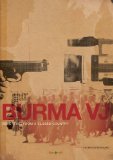In 2007, nineteen years after a similar uprising was crushed by Burma’s military junta, frustrated citizens once again took to the streets. Led by troops of monks in peaceful demonstrations, they made their voices heard by the generals, demanding freedom and democracy. The reaction was swift and violent. Men with riot gear and guns descended on the demonstrators and after many clouds of tear gas, numerous beatings, and even some shootings, the government quickly broke the spirit of its people again.
These incidents, and the actions that led to them, were chronicled by a courageous group of video journalists called Democratic Voice of Burma. These men and women captured hours of footage, risking imprisonment and worse, and got that footage out to the world over the internet and through trusted couriers. The images they captured allowed the people of the world and, even more importantly, the people of Burma (to whom the footage was also broadcast), to see the truth behind the lies of the Burmese government.
Anders Østergaard’s Burma VJ tells the story of the uprising almost exclusively through footage taken by the DVB journalists. Using one of the reporters, a man named “Joshua”, as the point of view and the voice of his film, he starts by presenting a portrait of a land ruled by fear. Citizens riding a bus, for example, are afraid to complain about fuel prices being doubled due to the real threat of undercover secret police being present. Such complaints are grounds for arrest, so people keep to themselves when strangers are around. And the fear of ever-present undercover agents is shown to be grounded in reality as the film continues. Every little act of defiance leading to the uprising has a life of no more than a minute or two, as the protesters are swarmed by these plainclothes agents and taken away.
As the film continues, and more small protests take place, we get a clear sense of hope from people. And when the nation’s monks take to the streets in support of the people, this bolsters the courage of the citizenry even further. Shots of crowds of people in the streets and on rooftops, cheering at the monks and shouting slogans calling for freedom and democracy, are made even more moving because of the time Østergaard takes at the start of the film to establish the oppression and fear these people live with.
As a documentary, Burma VJ is far from perfect. Østergaard muddles things up a bit at times by using re-enactments that are not specifically noted as such, a pity since it gives ammunition to the Burmese government’s claims that the DVB reporters are spreading lies and misinformation. We are also left in the dark about how the footage makes its way from Burma to Oslo, Norway, how Joshua coordinates his squad of VJs from Thailand (due to an arrest, Joshua is forced to flee Burma early in the film and is stationed in Thailand), or even how the footage is broadcast into Burmese homes.
Despite these shortcomings, Burma VJ is an astounding chronicle of the courage of ordinary citizens, the horrors the people of Burma face under their current regime, and the power of new media. It is a hope-filled illustration of just how much of a threat reporters like Burma’s VJs are becoming to oppressive governments who have traditionally controlled the flow of information.
Video
Burma VJ is presented in a 1.85:1 format. The images vary in quality since most of the footage was shot on everything from small handheld camcorders to phone cameras. Some footage is shot from inside bags designed to conceal the cameras within and much of the footage is shaky. However, the images that these cameras capture is so captivating that you will hardly notice the lapse in quality from your latest Hollywood release.
Audio
The film’s audio is presented in English and Burmese stereo with optional English subtitles. Again, since the bulk of the film was shot guerilla-style on handheld cameras, there is not any polish to speak of in the audio department. What is there, however, is clean with clear dialogue.
There is also an excellent audio commentary track provided with director Anders Østergaard and film critic John Anderson. This commentary is full of fascinating facts about every aspect of the film and is a valuable addition to the film itself.
Special Features
Fighting For Freedom: An Interview With Joshua (10:46): An enlightening interview with Joshua talking about his past, how he came into the movement, etc.
Burmese Monks’ Stories From the Uprisings: Four interviews with monks who participated in the uprisings of 1988 and 2007. Each one runs around 6:00.
A Message From Richard Gere (4:30): I suppose this is almost a mandatory feature on a dvd chronicling oppressed people in Asia.
Crossing Midnight (29:08): A short documentary about a refugee hospital on the Thai/Burmese border founded in 1988 by a Burmese doctor and some students who fled their country after the uprising.
Final Thoughts
Burma VJ is a powerful film that documents an important incident in world history. The way its footage was captured adds to the immediacy of the events and the film is harrowing, horrifying, and moving, all within a running time of 89 minutes. If you have any interest in politics or are a lover of good documentaries, this is definitely worth purchasing.





